Why Read This Article?
Finish Nailer Repair - Replacing the Driver Guide (Ridgid Part # 79004001022)
Article Breakdown
Finish Nailer Repair - Replacing the Driver Guide (Ridgid Part # 79004001022)
For article about "Circular Saw Blade Types"-Click here.
Why Are Saw Blades So Complicated?
This is because standard blades are:
1. used, as mentioned, in several types of saws that sometimes require blade design changes or variations,
2. even within the same saw type, a large variety of blade designs can be used to optimize cutting through different materials, and
3. blade designs are also modified to suit them to a certain types of cuts. These saw type, material type, and cut type demands are met in each specialized blade by a combination of several measurements and design factors. Then, most commonly, the blade is advertised and named for either its application material, the type of saw it is used in, cut type, or any combination of those general features. (For Example: a saw blade designed for cutting melamine with a miter saw might be advertised and named a "Melamine Blade," or "Melamine Miter Blade," simplifying how the blade is identified. What makes a melamine miter blade suited for its task is a negative hook angle, having a slightly larger than average tooth count, being designed with HiATB cutting teeth, and having a thin kerf.) But manufacturers are not always so specific, requiring customers to be more familiar with all the ins and outs of standard saw blade design in order to make the best purchases. This Bosch 10" ATB 5/8" Arbor 40 Tooth Table Saw Blade, for example, is a "general use" blade, but a shopper would have to know that this combination of measurements and features means, "for general use" when translated. To get started, we discuss basic information about saw blade parts, blade measurements, blade materials, cutting tooth design, and other features. Understanding the effects of these design variations on blade performance and function make it possible to match a blade to a job by these criteria. [Back to top] Parts of a Saw Blade The major parts of a saw blade are:
Cutting Teeth-
The sharpened edges of the blade. There are a number of different saw blade tooth designs, including ATB, ATB+R, HiATB, TCG and HR (see below).
Arbor Hole-
The center hole of the blade. Although an obvious feature, arbor holes must be very accurately sized and centered on the blade for the blade to perform well. Arbor hole size also plays a role in matching a blade to its work and saw type.
5/8" and 1" are the two most common arbor hole sizes.
Gullet-
These are the cut out swoops in front of each cutting tooth. Gullets allow saw dust and chips to be ejected from the blade and cutting area.
Plate-
The plate of a blade includes everything but the teeth of the blade. Quality plate manufacture, and correct plate-width-to-teeth-kerf ratio are important for good blade performance.
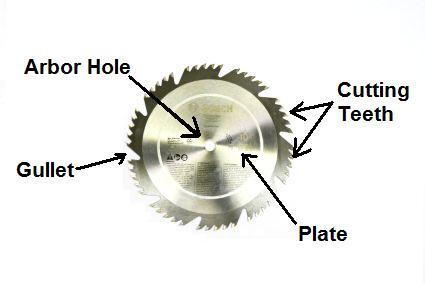
Expansion Slots & Holes-
Cuts in the blade that start from the outside edge are called "expansion slots," and they usually include small holes at the end of a curved shape. These cuts give the blade a little room to expand when heating up during use, and they help dissipate some of the heat in the blade.
Keeping heat down like this helps saw blades cut more efficiently and last longer. Expansion cuts also help reduce blade vibration a little.
Sometimes the holes at the ends of these cuts are filled with copper plugs. These are for reducing noise while the blade is in use.
Laser Cuts-
Laser cuts are one of the newer features added to saw blades to reduce vibration. By making microscopic cuts in the side of the blade, natural tension and rigidity in the blade's material is released.
One of the cool ways to distinguish this design difference is to find an old blade without laser cuts, dangle it between two fingers, and give it a whack your knuckles. An uncut blade with all that tension still in its material will sing a solid tuningfork-like ring when struck. Laser cut blades will make a dull thud, and that's a good thing. [Back to top] Saw Blade Measurements Even minor changes in saw blade measurements will change the nature of the blade's specialty and performance. Important saw blade measurements:
Number of Teeth-
Each saw blade has a fixed number of teeth, obviously. How densely or not densely packed those teeth are along the circumference of the blade determines some of the blade's characteristics.
How big a blade is (it's diameter) will partially determine the number of teeth. That is to say that blades of larger diameter have more teeth on average than smaller blades by virtue of simple physics and statistics, but the number of teeth for a specific blade is a very carefully chosen design feature.
Because of the varying blade sizes, it's best to think about number of teeth in terms of how closely packed they are, or #of teeth/inch.
Blades with fewer teeth per inch cut more aggressively, require less power to operate, and generally have a faster feed rate, but they also make rougher cuts. Blades with more teeth per inch than average will make smoother, slower cuts, and also require more horsepower. [Back to top]
Kerf-
Kerf is the width of the cut that a saw blade makes, the width of its cutting teeth.
The most common kerf is 0.125" (1/8"), because, especially in woodworking, the "round" 1/8" figure makes it easy to adjust measurement lines to account for material loss. Because of this, we refer to 1/8" kerf blades as the average to functionally talk about saw blades.
There are pluses and minuses to thick- and thin-kerfed blades for a given application.
Blades with a thicker kerf need more energy, and, of course, take more material out of the work. But they also are more likely to withstand heat buildup, wear less, resist vibration, and are prone to make cleaner cuts in most materials. Thicker kerfs are typically for slower, more precise cutting.
Thinner kerf blades cut down on how much power is necessary to run a blade, and are generally great for fast, abrasive ripping cuts; however, their thin design makes them more susceptible to heat damage, vibration, and fast wear. Some blades are named and advertised specifically as "thin kerf" blades.
Blades advertised as "thin kerf" blades usually include specific design modifications that attempt to bridge the gap between thin kerf pros and cons, making the thinner blades adaptable to slightly harder materials and heavier workloads. [Back to top]
Plate Width-
The measurement of a blade's plate width is separate from the kerf width, because the plates of most blades are slightly thinner than the blade's teeth (kerf). The difference between these two widths is called the radial side clearance, allowing material to more easily leave the work area and preventing the blade from binding in its cut.
Plate width is a determining factor for matching a blade to its tool. See a saw's user manual for this and other blade measurement specifications. [Back to top]
Diameter-
Blade diameter is no mystery, but it is one of the major factors for identifying a compatible blade. [Back to top]
Hook Angle-
One way or another, the cutting teeth of a saw blade are going to occupy some angle in relationship to the rotation of the blade. In other words, the sharp edges of a saw blade are designed to make contact with material at a specific angle for optimum performance, depending on a number of factors.
Hook angle is the angle measurement made between the situation of the blade's cutting teeth and an imaginary line drawn across the diameter of a blade.
Zero Hook Angle is one where the teeth cutting edges exactly line up with the blade's diameter line, and it is the least common.
Positive Hook Angle is one where the angle of the teeth lean toward the rotation on the blade and is the most common.
Negative Hook Angle is where the teeth of the blade are angled to lean away from the rotation of the blade.
This measurement is a little more complicated, but extremely critical. Each style is suited for either a certain type of material, saw, or some combination.
In all cases, the hook angle is designed to keep put pressure on the work and pin it to the saw, to prevent material bounce-back, and, in some cases, to prevent tearout.
Positive hook angle blades are generally for circular saws, table saws, and ripping saws. However, negative hook angle blades are sometimes used for cutting melamine on table saws, reducing the risk of chipping and tearout. For saws that use positive hook angle saws, a larger positive hook angle value on a blade means a more aggressive cut.
Negative hook blades are usually for miter saws, radial arm saws and their variations, because their opposing cutting direction requires an inverse angle to pin the work down.
Zero hook blades are most commonly used for metal applications. [Back to top]
Bevel Angle-
This measurement only applies to blades with some "bevel" style tooth design (ATB, ATB+R, HiATB, etc.). A steeper bevel angle makes for a finer-cutting saw blade, such as in High Alternating Top Bevel (HiATB) blades. [Back to top] Saw Blade Materials Although there are still some steel blades floating around on the market, most saw blades are manufactured today with carbide teeth. Carbide is an extremely hard but brittle material that is actually a powder before it is infused with metals. Manufacturing processes fuse powdered carbide into steel blade teeth for exceptional strength, sharpness, and durability. Because carbide is very difficult to sharpen, this also means that most blades must be taken to shops for sharpening these days, but those trips should be fewer and farther between. Saw blade shoppers will no doubt run into the mighty "Carbide Grade Scale" eventually, which can over-complicate itself in a hurry. For most power tool accessory uses, the carbide scale advances from C1 to C4. This scale does not suggest quality, but rather, each type of carbide (C1, C2, C3, & C4) is suited for different work. C1 and C2 carbides are coarser, more impact-resistant than others, but are more susceptible to grinding and friction wear. Because of this, it's most common to see this kind of carbide used in masonry equipment. C3 and C4 carbides are finer, less impact-resistant, but much more durable against abrasive wear. Look for C3 and C4 carbide in saw blades for the best results. [Back to top] Cutting Tooth Style Cutting tooth style refers to two major things:
1. The shapes of the tops of a blade's cutting teeth (It's best to think of these shapes from a profile view of the blade), and
2. The pattern of differently shaped teeth situated along the blade. Each of the specific designs of cutting tooth shape and orientation explained below is suited for specific kinds of cuts, materials, and sometimes, saws. FT (Flat Top) FT blades are the fastest and coarsest-cutting blades, and they are used exclusively for ripping cuts along the grain of the wood.
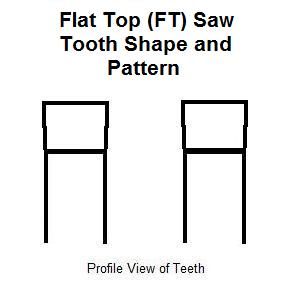
FT blades are also called HR blades, short for "heavy ripping," and FTG blades for "Flat Top Grind."
[Back to top]
ATB (Alternating Top Bevel)
Alternating top bevel is a saw blade tooth design that alternates opposing bevel-cut teeth along the blade: one tooth's bevel will face one side of the blade plate, and then the next will face the opposite direction, and so on.
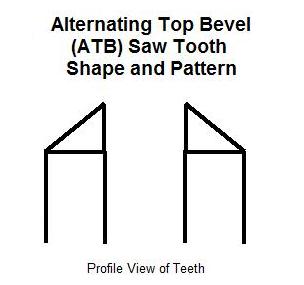 The bevel design makes cleaner edges on the sides of the cut than FT tooth style blades. ATB blades are the most common, because their design puts them about in the middle range of suitable cut styles, and material hardness.
ATB blades are better for crosscutting, although they can handle some ripping as long as the material is not too thick or hard.
They are great for cutting most natural woods, but they can also cut through some harder fabricated materials like plywood, particle board, and laminate, if the material is not too thick.
[Back to top]
HiATB (High Alternating Top Bevel)
The bevel design makes cleaner edges on the sides of the cut than FT tooth style blades. ATB blades are the most common, because their design puts them about in the middle range of suitable cut styles, and material hardness.
ATB blades are better for crosscutting, although they can handle some ripping as long as the material is not too thick or hard.
They are great for cutting most natural woods, but they can also cut through some harder fabricated materials like plywood, particle board, and laminate, if the material is not too thick.
[Back to top]
HiATB (High Alternating Top Bevel)
High Alternating Top Bevel blades are the same as regular ATB blades except for one difference. The bevel angle on HiATB blades is at a sharper angle than the bevel angle of ATB blades.
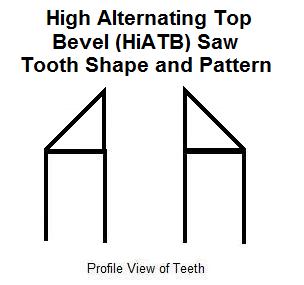
This small alteration makes for an even finer, cleaner cut in woodworking applications.
HiATB blades also encounter some limitations with this feature, in that that the steepness of the angle makes the cutting edges of the blade teeth much more susceptible to wear. Also, the fineness of the cut will slow down the feeding speeding of the blade, but these are hardly limitations when the delicacy of the blades is required.
HiATB blades are also commonly used for materials that pose a high risk of breakout and chipping like melamine and veneer. It's a good idea to choose HiATB blades made with the finest, C4 grade carbide for the smoothest cuts and better durability.
ATB+R (Alternating Top Bevel + Ripping)
Most "Combination" blades are some variation of an ATB+R cutting tooth pattern. The "combination" comes from combining the precision of ATB cutting teeth with an occasional ripping tooth (+R), an FT tooth.
This combination is, most commonly, a series of two pairs of ATB teeth (four teeth total), followed by one FT cutting tooth. Because of this, "Combination" blades are often called "4 & 1" blades as well.
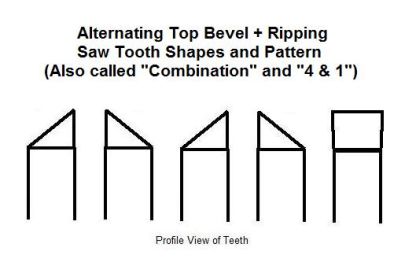
ATB+R blades are also manufactured with different tooth pattern variations. ATB+R also usually have larger gullets for ripping, although their ability to rip thicker material is limited.
Although "all around blades," "Combination" and other ATB+R blades are versatile-but-limited in each area, because they do not necessarily emphasize any one design feature.
The Triple Chip Grind saw blade design is made for durability. They alternate 1:1 between FT teeth and a special "trapeze" style tooth.
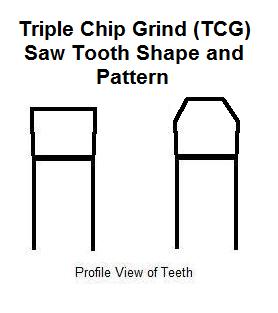
The trapeze teeth on these blades are slightly raised to allow for cleaner cuts than a simple FT tooth can provide, but their low profile also makes them extremely less vulnerable to wear than, say, ATB teeth.
Because of this combination of durability and finer cutting, TCG blades are designed mainly for hard materials like laminates, solid surface, MDF board, plastics, aluminum, acrylic, glued materials, plastics, and other non-ferrous metal cutting. Trying to cut these materials with non-TCG blades risks poor cuts and heavy blade wear, unless such blades are specifically designed for some kind of specialty cut on harder material applications.
Conclusion
Understanding the saw blade measurements and design features discussed in this article is critical when shopping for saw blades.
Each saw blade is designed for a specific kind of use or uses. Blade buyers will get the best work performance and longest life out of their saw blades when they match its features to the material, saw, and type of cut being made.
Visit our Standard Saw Blades page here at eReplacementParts.com to view our large selection of circular saw blades. Blade searches can be narrowed by the measurements and features discussed in this article for convenient matching.


















































